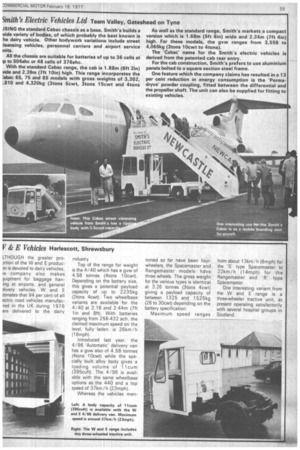V & E Vehicles Harlescott, Shrewsbury
Page 57

If you've noticed an error in this article please click here to report it so we can fix it.
LTHOUGH the greater pro)rtion of the W and E produc)n is devoted to dairy vehicles, le company also makes luipment for baggage haning at airports, and general alivery vehicles. W and E itimates that 94 per cent of all ectric road vehicles manufacred in the UK during 1976 ere delivered to the dairy industry.
Top of the range for weight is the 4/40 which has a gvw of 4.58 tonnes (4tons 10cwt). Depending on the battery size, this gives a potential payload capacity of up to 2235kg (2tons 4cwt). Two wheelbase variants are available for the 4/40 at 2.16 and 2.44m (7ft tin and 8ft). With batteries ranging from 256-432 ach, the claimed maximum speed on the level, fully laden, is 26km /h (16mph).
Introduced last year, the 4/96 'Automatic' delivery van has a gvw also of 4.58 tonnes (4tons 10cwt) while the specially built alloy body gives a loading volume of llcum (395cuft). The 4/96 is available with the same wheelbase options as the 440 and a top speed of 37km /h (23mph).
Whereas the vehicles men honed so far nave been fourwheelers, the Spacemaster and Rangemaster models have three wheels. The gross weight for the various types is identical at 3.26 tonnes (3tons 4cwt) giving a payload capacity of between 1325 and 1525kg (26 to 30cwt) depending on the battery specification.
Maximum speed ranges from about 13km/h (8mph) for the "S type Spacemaster to 22km/h (14mph) for the Rangemaster and 'IR' type Spacemaster.
One interesting variant from the W and E range is a three-wheeler tractive unit, at present operating satisfactorily with several hospital groups in Scotland.








































































































